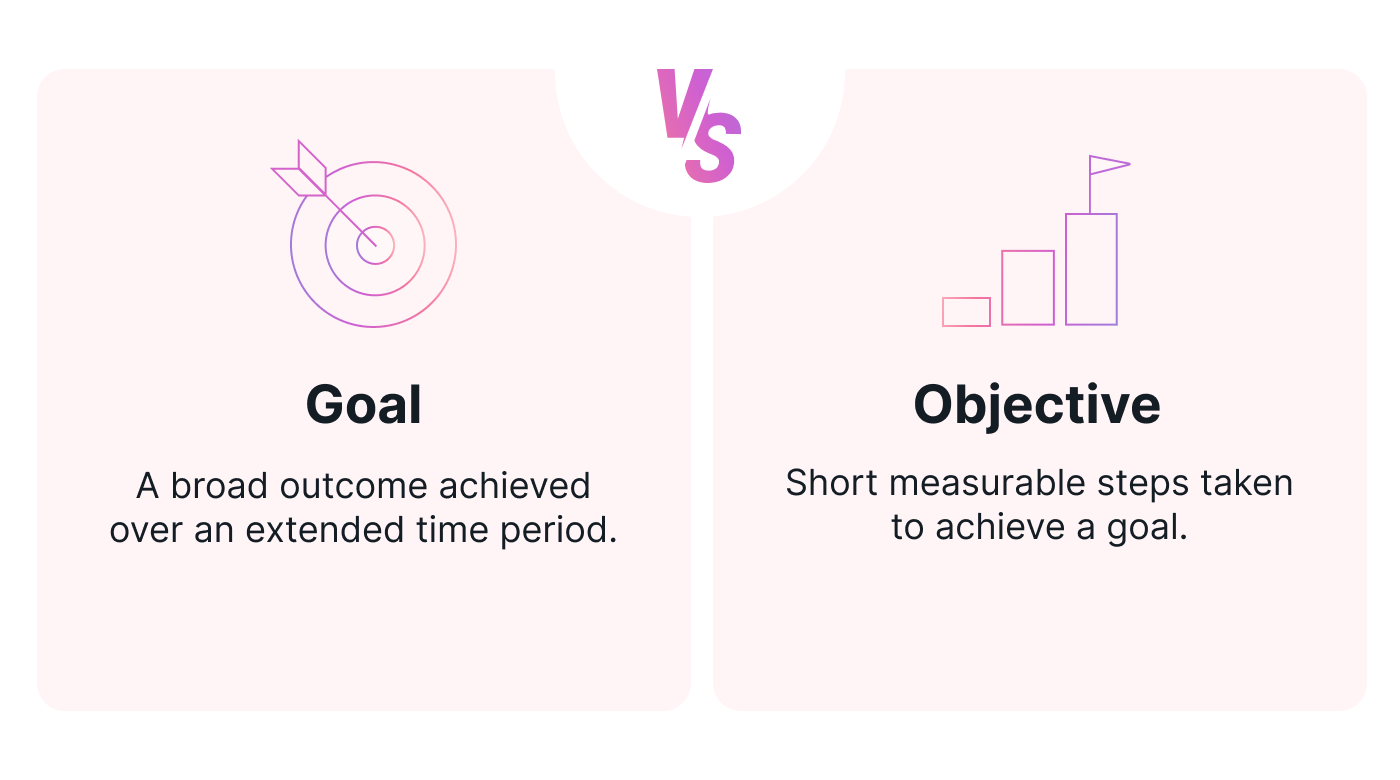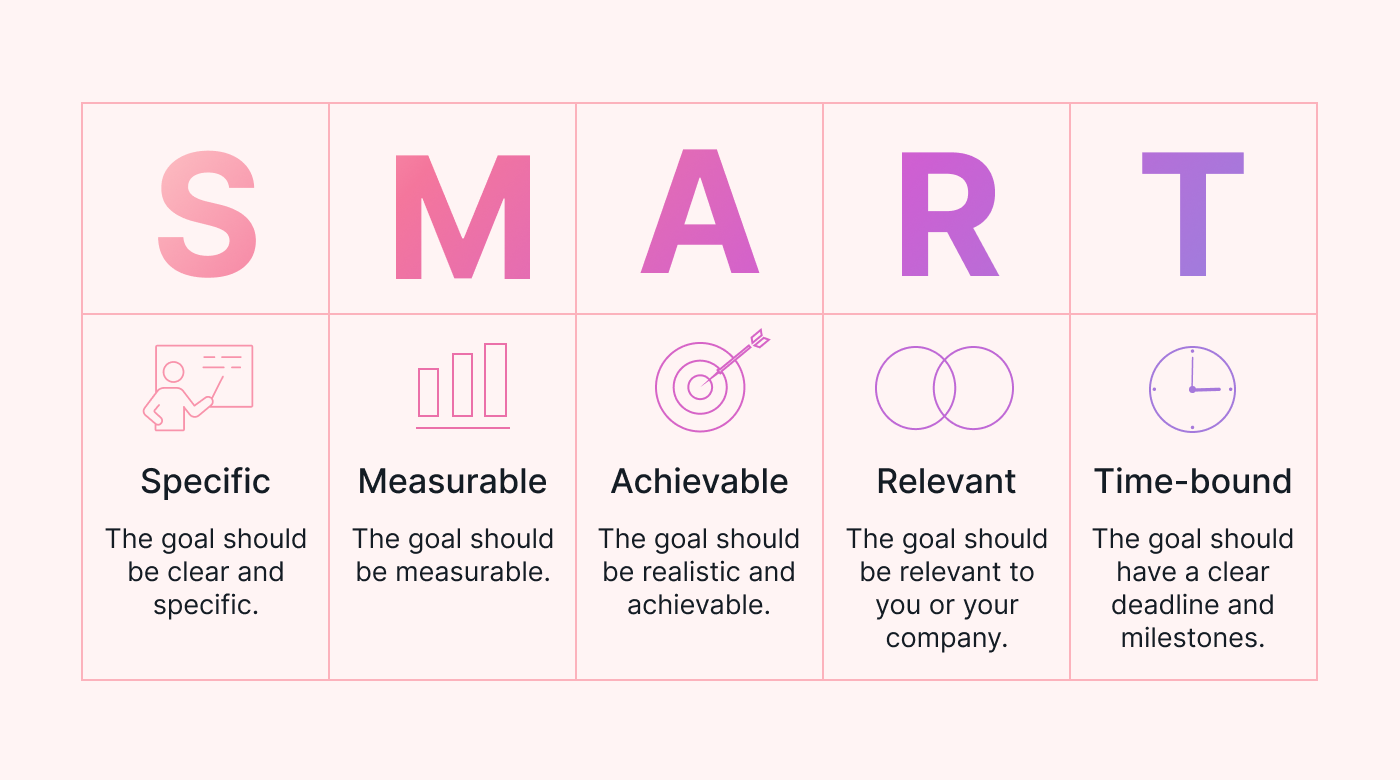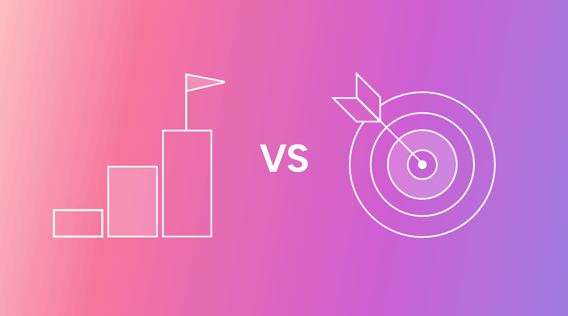Though you might have heard the terms used interchangeably, there are critical differences between goals and objectives. Both are crucial to success, but how should each be used to optimize your organization's outcomes?
A 2022 report by Price Waterhouse Cooper showed that 37% of projects fail due to a lack of correctly defined objectives and goals. As a project manager, your ability to manage team goal-setting with measurable objectives is central to your role.
In fact, a 2022 study by KPMG found that driving change within organizations was voted as a top skill required by project managers of the future with 33% of votes, beaten only by communication with 35% of votes.
But where to start? Do you need both goals and objectives? How do they work together? Getting your team excited about organizational goals can be hard enough, especially if they don't know how to achieve them. This is where setting clear and effective objectives can be a game-changer.
In this article, we’ll explore the different types of goals and objectives and why these two terms are anything but interchangeable. We'll provide actionable methods for better goal setting and real-world examples of goals and objectives at work so you can create measurable objectives and communicate their purpose effectively.
What is a goal vs. an objective?
Before we take a deep dive into the differences between how goals and objectives are used, let’s first take a brief look at what goals and objectives actually are.
A goal is a large and broad organizational (or personal) outcome achieved over a longer period.
An example of this might be: Increase website conversions by 15% over the next five years.
Objectives, however, are smaller, specific, and measurable shorter-term steps that need to be taken to achieve the larger goal.
Examples of objectives that break down the larger goal, increase website conversions by 15% over the next five years, might look like this:
- Create a new high-converting landing page that gets more newsletter subscribers.
- Add a newsletter opt-in form to the website to give readers an easy place to opt-in.
- Create a free downloadable that can be used in exchange for a first name and email address.
- Create a high-performing sales funnel that takes website visitors from downloading an ebook to booking a consultation with our sales team.
As you can see, the larger goal is broad enough to encompass a range of complex objectives, each requiring a number of tasks and projects of their own.
If we look at objective four as an example, we can already see that we'll need to break this into multiple tasks across a range of departments:
- Copywriter to write the copy for the funnel landing pages and ad copy.
- Copywriter to write the ebook that will be offered as a free guide.
- Social media team to set up ads and organic posts to drive traffic toward the ebook opt-in page.
- Graphic designer to create assets for socials and ads.
- Graphic designer to design landing pages.
- And many more.
 |
When broken down into effective objectives and measurable tasks, achieving such a broad organizational goal becomes a simple matter of daily to-dos.
A short history of goal-setting theory
Edwin A. Locke, an American psychologist, pioneered psychological research in goal-setting as a tool for improved human performance. His article explored long-term goals and highlighted how the difference between goal size and complexity impacted goal success.
More complex goals were shown as more likely to be achieved than simple goals with a "do your best" approach. When you consider how objectives ground ideas in day-to-day reality, it's easy to understand why.
Team objectives support a larger company goals framework that encompasses your organization's overall mission, vision, and business plan, trickling down into a daily tasks list for employees.
What is the difference between how objectives and goals are used?
Now that we know how goals and objectives differ, let's look at how they're used as part of a larger organizational framework.
Goals are used to unite a team (or drive an individual) toward a target state in the future. This may be a desired company position (25% profit by July 2024) or a team target (5,000 new leads through the company website by Nov 2023).
The goal acts as the bullseye on the horizon that, if achieved, encompasses a series of successes across various relevant milestones or tasks (objectives).
Goals are used to focus deliverables on those most essential to the desired long-term outcomes of your company or team.
Objectives are used to keep the team on track with measurable activities that must be completed to achieve the larger goal.
While goals are broad and use conceptual, high-level language that doesn't include a list of the tasks required to achieve them, objectives are detailed with measurable milestones, due dates, and tasks to ensure completion.
Goals may be unquantifiable (provide the highest level of customer satisfaction in the market), where an objective aiming to achieve this goal will be able to be quantified or measured (overall NPS customer satisfaction rating of 9 or above across all customer-facing representatives.)
We use goals to set the direction and objectives to get there.
What comes first? The objective or the goal?
While goals set the destination of an organization or team, objectives define the stepping stones to get there.
This theory of breaking goals into measurable steps dates back as far as 2,500 years ago, when Chinese military strategist, Sun Tzu, wrote “The Art of War.” In it, he wrote: “Strategy without tactics is the slowest route to victory. Tactics without strategy are the noise before defeat.”
Goals without objectives are difficult to achieve. Objectives (or individual tasks) for tasks' sake don’t contribute to overall success if they aren’t tied to a bigger, ultimate goal.
Goals come first as part of a wider company mission and vision or business plan. They are then broken down into the steps (measurable objectives) that will need to be undertaken to achieve these larger goals.
Different types of goals have different focuses and will require various approaches to the objectives set to achieve them.
What are the different types of goals?
We’ve explored the role of goals and objectives and how they're used to achieve organizational objectives. But, not all goals and objectives are created equal. Here are some key differences:
![Illustration of types of goals [time-based, outcome-oriented, process-oriented]](https://www-cdn.usemotion.com/webflow-export/blog/goals-vs-objectives/6489c97189ca20cff66aa795_types_of_goals_vsae.png) |
Time-bound goals:
- Are deadline-driven
- Focus on setting timely milestones
- Focus on ‘when’ a goal must be achieved by
Outcome-oriented goals:
- Are outcome-driven
- Focus on the result
- Focus on ‘what’ will be achieved
Process-oriented goals:
- Are process-driven
- Focus on improving systems and processes in aid of a goal
- Focus on ‘how’ things are done in the organization
What are the different types of objectives?
![Illustration of types of objectives [operational, strategic, tactical]](https://www-cdn.usemotion.com/webflow-export/blog/goals-vs-objectives/6489c97189ca20cff66aa79e_types_of_objectives_v4yp.png) |
Operational objectives:
- Are short-term, time-based activities that seek to meet operational goals.
- Are concerned with the organization of task schedules.
- Align teams across daily, weekly, and monthly deliverables.
- Focus on detailed instruction and immediate task results.
Strategic objectives
- Are purpose-driven activities.
- Are concerned with the overall result after the completed project timeline.
- Align tasks to organizational mission and business goals.
- Focus on connecting project milestones to the bigger picture.
Tactical objectives
- Are short-term time-based activities focused on the immediate result of tasks.
- Are concerned with the many smaller tasks that make up more complex projects to reach organizational goals.
- Align team to short-term deliverables.
- Focus on the day-to-day immediate short-term tasks.
Goals and objectives examples for work
Let’s look at these goals and objectives in action with some more real-world examples.
Example One: Time-bound goal with objectives
We will increase revenue by 15% by the end of the financial year 2025.
Some objectives might be:
- Increase customer cart value by $50 per transaction
- Increase pricing by 3.5%
- Increase marketing budget by 15%
Note: As objectives align with a time-bound strategic goal, these objectives clearly outline what needs to happen to achieve the goal. The next step would be to assign SMART (Specific, Measurable, Achievable, Realistic, Time-bound) tasks that, when completed, accomplish these objectives and, ultimately, the time-based goal. More on SMART in a bit.
Example Two: Outcome-oriented goal with objectives
We will win the industry award for best customer service in 2024.
Some objectives might be:
- Implement NPS scoring to measure our level of customer satisfaction
- Implement a 10-email direct marketing campaign to encourage customers to nominate us for the award
- Run a training day in April 2024 to upskill all front-line staff
Note: These tactical objectives are tangible, actionable milestones that can be broken down into tasks to achieve the outcome-oriented winning of the award for best customer service.
Example Three: Process-oriented goal with objectives
We will automate task assigning using a smart calendar to simplify project management.
Some objectives might be:
- Narrow down a list of software that can automate task assignment
- Brief department heads on operational change to how their projects will be managed
- Write SOP for project managers on how to use chosen software
- Implement the chosen software across one project to fine-tune execution in Q1, then debrief on outcomes
- Optimize based on Q1 learnings through Q2
Note: A process-oriented goal focuses on improving how things are done rather than what is done. In support of this process-driven goal, operational objectives ensure all departments align across milestones and tasks can be assigned with step-by-step instructions.
How to set SMART goals and objectives
SMART goals are a popular framework for setting and achieving goals and objectives. SMART is an acronym for:
 |
Specific: The goals and objectives should be clear and specific, answering the questions: what, why, and how they'll be accomplished.
Measurable: The goal and objectives should be measurable so that progress can be tracked and success can be determined on completion.
Achievable: The goal and objectives should be realistic and achievable, taking into account the resources and constraints as well as relevant timeframes.
Relevant: For business goals, the goals and objectives should be relevant to the organization and align with its overall mission and strategy. For personal goals, the goal should be relevant to you and align with your overall life mission.
Time-bound: The goals and objectives should have a clear deadline and time frame, with specific milestones to help track progress.
Applying KPIs to SMART goals and objectives
When setting SMART goals and objectives, it's crucial to determine what success will look like.
How will the team know when the objective has been completed? How will you know if it has been done correctly? This is where key performance indicators (KPIs) play a vital role.
Peter Drucker famously wrote: "What gets measured, gets done." KPIs act as a data point to quantitatively determine success.
Examples of goal KPIs might include:
- Customer retention scores.
- Profit margins.
- Cost per lead.
- Average cart value.
- Client retention rate.
- Revenue growth.
Examples of objective KPIs include any feature you have determined as the measurable component of success, such as:
- Due dates for task completion.
- Quantity of social media posts live each week.
- Number of clicks on relevant links in email marketing.
How to measure goals and objectives outcomes
Effective measurement of your team’s objectives will be determined by what was defined in your SMART objectives. Here are just some of the ways you can measure your success:
- Review your KPIs. What data was determined to be the measurable element of your SMART goal and objectives?
- If you set process-oriented objectives, determine if relevant system and process improvements have been made.
- Using project management software, review task status reports. Determine whether milestones are met on time and meet all requested requirements.
The key to measuring outcome success is ensuring the objectives were set effectively in the first place.
Set strategic objectives to accomplish your organization’s goals
As you've now seen, goals and objectives are not interchangeable. Goals are the outcome you want your team to work towards, and objectives are the steps to help them get there. Both are critical to the project and organizational success and should be SMART.
As a project manager responsible for setting goals and objectives for your team, you are now armed with the skills to effectively set time-bound, outcome-oriented, and process-oriented goals. Your team will have all the clarity they need with your ability to break these goals into tactical objectives and relevant tasks.
But it doesn't have to be arduous work.
Use project management automation to track and measure goals and objectives
Make setting SMART objectives a breeze using Motion to list your organizational and personal goals. Break down objectives into team projects and tasks, and assign tasks and deadlines automatically using Motion's Intelligent Calendar. Track your objectives' status in real-time and keep your team and other stakeholders updated with accurate reporting on goals, objectives, and tasks with detailed Kanban boards or Gantt charts.





